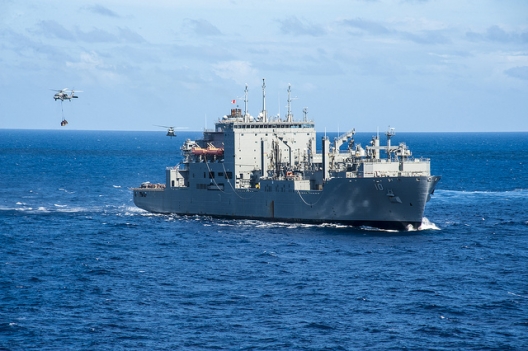 Typhoon Haiyan, the strongest typhoon on record, has devastated the Philippines. Nearly four thousand people have been confirmed dead, and the casualty figure is mounting quickly. More than twelve thousand people have been injured and almost two million people have been displaced. The United States is responding by sending the George Washington carrier strike group and a Marine Expeditionary Unit to the region. More assets may be dispatched in the coming days as part of effort, dubbed Operation Damayan. Already US forces are busy clearing roads, ferrying in supplies, and evacuating civilians.
Typhoon Haiyan, the strongest typhoon on record, has devastated the Philippines. Nearly four thousand people have been confirmed dead, and the casualty figure is mounting quickly. More than twelve thousand people have been injured and almost two million people have been displaced. The United States is responding by sending the George Washington carrier strike group and a Marine Expeditionary Unit to the region. More assets may be dispatched in the coming days as part of effort, dubbed Operation Damayan. Already US forces are busy clearing roads, ferrying in supplies, and evacuating civilians.
The US military is called upon to conduct humanitarian operations, large and small, nearly every year and recently has taken on some mammoth humanitarian efforts. For example, it managed to conduct three major humanitarian operations—in Japan after the earthquake and tsunami in 2011, in Haiti after the 2010 earthquake, and in Indonesia after the Indian Ocean tsunami in 2004—all while also being engaged in two big counterinsurgency operations in Iraq and Afghanistan. The unique abilities of the US military were on display during all of these efforts. The Haiti earthquake knocked out the control tower at the Port au Prince airport, making it impossible to airlift in aid shipments to Haiti. US Air Force combat controllers, who normally are used to help bring in airstrikes in support of ground units, parachuted in and set up rudimentary air control operations, allowing badly needed aid to start flowing into Haiti. In Indonesia, the tsunami washed away ports and roads, making it difficult to get supplies ashore. The Navy used its hover craft, able to close carry close to fifty tons of supplies, deployed aboard amphibious ships, to simply hover onto the beach with crucial aid. During the tsunami relief effort, the USS Abraham Lincoln served as the coordinator of the US response and the strike group flew some 1,800 sorties, delivered 2,700 tons of food, water, and medical supplies, and evacuated over 3,000 people.
The US military can hardly be said to be, at heart, a development, humanitarian, or reconstruction agency. Indeed, the US military has at times balked at taking on these types of missions, fearing that they will degrade the military’s fighting abilities. However, it does bring something that few other organizations can: the ability to move large numbers of people and essential supplies into inhospitable areas and stay and operate there for a very long time. The conditions after a natural disaster can be just as nasty as during and after combat, with damaged roads, airports, and ports, no running water, no electricity, and widespread insecurity.
The trend lines suggest that the US military will be called upon to do more operations such as Operation Damayan in the future. Climate change is expected to generate more adverse weather events while the emergence of large urban spaces near littoral areas will make them especially vulnerable to natural disasters. To boot, these trends will all converge in Asia. But these negative developments also present an opportunity for the United States as it responds to alleviate human suffering. Humanitarian operations should be considered an integral part of the US pivot to Asia, which arguably has so far almost exclusively focused on the reorientation and exercise of US’ hard power assets. Humanitarian efforts will boost the image of the United States in a region of key interest to Washington and also provide a ready-made opportunity for the US military to work alongside regional allies and partners on a day-to-day basis. There may even be a possibility to work directly with the Chinese military, which could help foster a better military to military relationship with that rising nation. In short, a generous and organized US humanitarian response to the next crisis such as Typhoon Haiyan would be a tangible demonstration of US commitment to a stable and secure Asia-Pacific region.
In a post-Iraq and Afghanistan world the US military appears eager to shed the softer aspects of its mission set, in order to concentrate on core military functions. In the case of humanitarian support operations, that would be a mistake. Hard power delivered softly may very well be a key part of the US’ continued global leadership in the Pacific century.
Magnus Nordenman is a deputy director in the Brent Scowcroft Center on International Security.
Image: An MH-60S Sea Hawk helicopter from the Island Knights of Helicopter Sea Combat Squadron (HSC) 25 prepares to deliver supplies to the aircraft carrier USS George Washington (CVN 73) during a replenishment-at-sea with the Military Sealift Command dry cargo and ammunition ship USNS Charles Drew (T-AKE 10) in support of Operation Damayan. (Photo: US Navy/Chris Cavagnaro/CC License)
